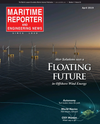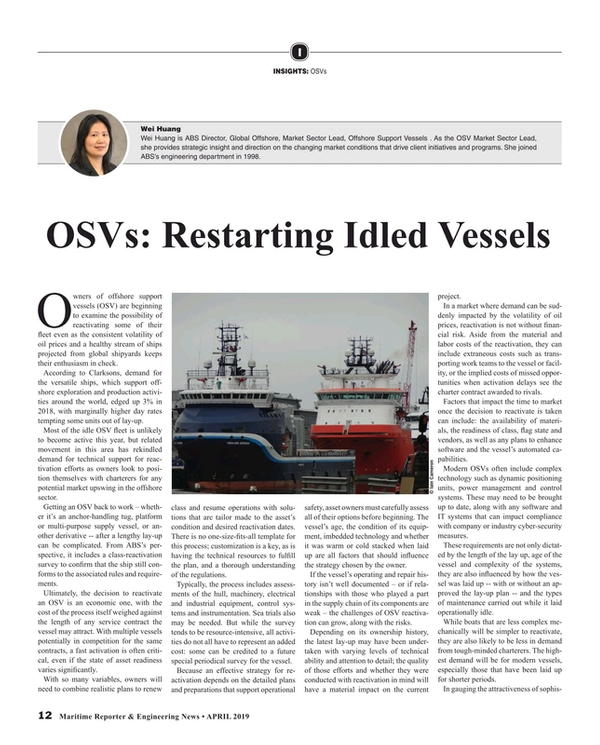
OSVs: Restarting that Idled Vessel
Owners of offshore support vessels (OSV) are beginning to examine the possibility of reactivating some of their fleet even as the consistent volatility of oil prices and a healthy stream of ships projected from global shipyards keeps their enthusiasm in check.
According to Clarksons, demand for the versatile ships, which support offshore exploration and production activities around the world, edged up 3% in 2018, with marginally higher day rates tempting some units out of lay-up.
Most of the idle OSV fleet is unlikely to become active this year, but related movement in this area has rekindled demand for technical support for reactivation efforts as owners look to position themselves with charterers for any potential market upswing in the offshore sector.
Getting an OSV back to work – whether it’s an anchor-handling tug, platform or multi-purpose supply vessel, or another derivative – after a lengthy lay-up can be complicated. From ABS’s perspective, it includes a class-reactivation survey to confirm that the ship still conforms to the associated rules and requirements.
Ultimately, the decision to reactivate an OSV is an economic one, with the cost of the process itself weighed against the length of any service contract the vessel may attract. With multiple vessels potentially in competition for the same contracts, a fast activation is often critical, even if the state of asset readiness varies significantly.
With so many variables, owners will need to combine realistic plans to renew class and resume operations with solutions that are tailor made to the asset’s condition and desired reactivation dates. There is no one-size-fits-all template for this process; customization is a key, as is having the technical resources to fulfill the plan, and a thorough understanding of the regulations.
Typically, the process includes assessments of the hull, machinery, electrical and industrial equipment, control systems and instrumentation. Sea trials also may be needed. But while the survey tends to be resource-intensive, all activities do not all have to represent an added cost: some can be credited to a future special periodical survey for the vessel.
Because an effective strategy for reactivation depends on the detailed plans and preparations that support operational safety, asset owners must carefully assess all of their options before beginning. The vessel’s age, the condition of its equipment, imbedded technology and whether it was warm or cold stacked when laid up are all factors that should influence the strategy chosen by the owner.
If the vessel’s operating and repair history isn’t well documented – or if relationships with those who played a part in the supply chain of its components are weak – the challenges of OSV reactivation can grow, along with the risks.
Depending on its ownership history, the latest lay-up may have been undertaken with varying levels of technical ability and attention to detail; the quality of those efforts and whether they were conducted with reactivation in mind will have a material impact on the current project.
In a market where demand can be suddenly impacted by the volatility of oil prices, reactivation is not without financial risk. Aside from the material and labor costs of the reactivation, they can include extraneous costs such as transporting work teams to the vessel or facility, or the implied costs of missed opportunities when activation delays see the charter contract awarded to rivals.
Factors that impact the time to market once the decision to reactivate is taken can include: the availability of materials, the readiness of class, flag state and vendors, as well as any plans to enhance software and the vessel’s automated capabilities.
Modern OSVs often include complex technology such as dynamic positioning units, power management and control systems. These may need to be brought up to date, along with any software and IT systems that can impact compliance with company or industry cyber-security measures.
These requirements are not only dictated by the length of the lay up, age of the vessel and complexity of the systems, they are also influenced by how the vessel was laid up – with or without an approved the lay-up plan – and the types of maintenance carried out while it laid operationally idle.
While boats that are less complex mechanically will be simpler to reactivate, they are also likely to be less in demand from tough-minded charterers. The highest demand will be for modern vessels, especially those that have been laid up for shorter periods.
In gauging the attractiveness of sophisticated ships, how they were laid up is the key; if they underwent limited preparation before lay up, the prospects for a quick reactivation fade.
In this state, activation is unlikely to be a quick process, as they will require thorough and systematic checks on a series of features and components, including but not limited to: oil analyses, hydraulic systems, all electronics, drives, switch gears, cooling systems, thrusters and stern seals.
The review will need to be measured and thorough; any omissions can result in early and costly failures, potentially negating the incentives for chartering the vessel.
Structural issues to be addressed during reactivation can include hull condition, corrosion, wastage and the replacement of parts. It is not unusual to find doors and hatches rusted and corroded on ships that have been idle, or general corrosion on deck, in ventilators and air pipes. The vessel must be checked for any unapproved modifications and repairs made during the lay up, or before.
The depth of the class-reactivation survey – whether the vessel requires a failure mode and effects analysis, or an audit under the International Safety Management or International Ship and Port Facility Security codes – needs to be fully understood by the owners and their technical support teams. If the vessel has been laid up for more than six months, an interim audit will be required by its flag state, too.
A few years of shrinking demand for OSVs since the decline in oil prices also may have prompted operators to scale back on more than just vessel capacity. Many may have had to reduce their workforces, a vital source of the kind technical expertise they need to restart vessel operations when signs of life come back to the market.
This is the technical gap that class aims to fill, especially those with significant offshore experience. ABS classed the first workboats to venture into the Gulf of Mexico in the early days of US offshore exploration; today it classes about one-third of the world’s OSV fleet.
To support owners as they develop plans to reactivate vessels and renew class, ABS draws on deep working knowledge of this specialist fleet, with decades of experience with specialized vessels, including anchor handling, supply, firefighting, dive support, pipelay, heavy lift, well intervention and stimulation, and oil-spill recovery vessels.
According to Clarksons, the global orderbook for OSVs represented about 10% of the active fleet at the end of last year, vs 14% at the end of 2017. Supply side pressures appear to be moving in the right direction for the reactivation-minded, but there is still considerable fragility in the market.
OSV owners will no doubt be watching those numbers and the price of oil as they consider the next steps for their idle fleet.

Wei Huang, ABS Director, Global Offshore, Market Sector Lead, Offshore Support Vessels. As the OSV Market Sector Lead, Dr. Wei Huang provides strategic insight and direction on the changing market conditions that drive client initiatives and programs. She joined ABS's engineering department in 1998, providing engineering plan review and approval, and subsequently participated in research and Rules development for marine and offshore structures with the ABS Europe Division in London, and the ABS Americas Division and ABS Corporate Technology in Houston. Dr Huang has Doctorate degree in Civil Engineering from the University of Portsmouth and a Master of Science degree in Ocean Engineering, and a Bachelor of Science degree in Naval Architecture from Shanghai Jiao Tong University in China.
Read OSVs: Restarting that Idled Vessel in Pdf, Flash or Html5 edition of April 2019 Maritime Reporter
Other stories from April 2019 issue
Content
- Maritime Fatigue: Just another band aid? page: 10
- OSVs: Restarting that Idled Vessel page: 12
- OSV Market: Which Way is Up? page: 14
- A New York State of Mind page: 20
- Interview: Astrid Skarheim Onsum, SVP, Head of Wind, Aker Solutions page: 24
- Maritime Autonomy: The Reality page: 28
- World Navy Report: Peru page: 38
- World Navies Report: Denmark page: 39
- World Navies Report: Belgium page: 39
- World Navies: Taiwan develops indigenous combat capabilities page: 40
- World Navies Report: Malaysia page: 41
- World Navies: Brazil´s Riachuelo Submarine page: 42
- Design: RNLI’s Shannon Class Lifeboat page: 44
- e-Navigation Passage Planning transformation page: 52


